R.J. Stowell's Blog: rjsomeone, page 84
March 10, 2018
Sound City
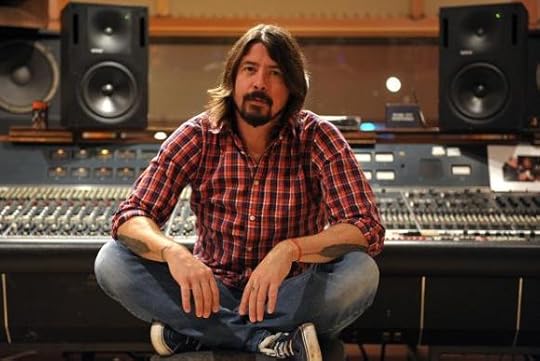 Sound City Studios was/is a recording studio incorporated in 1969, located down the street from an apartment my parent's managed in Van Nuys, California, and across the freeway from the now defunct Busch Gardens. The facility was formerly a production facility for the British amp manufacturer, Vox.
Sound City Studios was/is a recording studio incorporated in 1969, located down the street from an apartment my parent's managed in Van Nuys, California, and across the freeway from the now defunct Busch Gardens. The facility was formerly a production facility for the British amp manufacturer, Vox.Sound City contributed its signature analog sound to more than a hundred certified gold and platinum LPs. The studio was privately held from 1970, until it closed its commercial studio services in May 2011. Dave Grohl, former Nirvana drummer and current frontman for the Foo Fighters, purchased the Neve Electronics 8028 Console from Studio A, installing it in his private recording studio (and producing an amazing documentary of the studio). Sound City reopened 2016 with a completely renovated facility, but it's the history that concerns AM, particularly since I grew up just down the street.
In 1969, Sound City hosted the David Briggs productions Twelve Dreams of Dr. Sardonicus by Spirit and After the Gold Rush by Neil Young. Not a bad start, to say the least; Gold Rush arguably Neil's finest moment. On a more infamous note, cult leader Charles Manson made some recordings in Studio B, just a few months before the Manson family crime spree in the Summer of 1969.
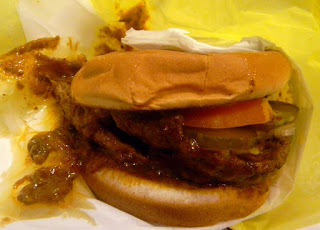 In the 1970s, Neil Young, Dr. John, Spirit, Crazy Horse, Nitty Gritty Dirt Band, Fleetwood Mac, and Leon Russell all recorded at the studio, and in 1974, Sound City championed a new artist from Gainesville, Florida, Tom Petty who recorded with a band called Mudcrunch. Petty would go on to have a 30-year relationship with the studio. Other artists who recorded at Sound City over the years include Foreigner, The Black Crowes, Johnny Cash (Unchained, 1996), Dio and the Red Hot Chili Peppers. Most famously, Nirvana’s Nevermind ranks up there with Weezer's Pinkerton, Death Cab for Cutie's Codes and Keys, The Dead's Terrapin Station and Elton John's Caribou.
In the 1970s, Neil Young, Dr. John, Spirit, Crazy Horse, Nitty Gritty Dirt Band, Fleetwood Mac, and Leon Russell all recorded at the studio, and in 1974, Sound City championed a new artist from Gainesville, Florida, Tom Petty who recorded with a band called Mudcrunch. Petty would go on to have a 30-year relationship with the studio. Other artists who recorded at Sound City over the years include Foreigner, The Black Crowes, Johnny Cash (Unchained, 1996), Dio and the Red Hot Chili Peppers. Most famously, Nirvana’s Nevermind ranks up there with Weezer's Pinkerton, Death Cab for Cutie's Codes and Keys, The Dead's Terrapin Station and Elton John's Caribou.In 1974, during the recording of Caribou, Elton John reportedly visited a nearby Tommy's Hamburgers for a chili-burger. The next day, the bitch was back for another. Stevie Nicks and Lindsey Buckingham enjoyed Howard Johnson's instead, right up Roscoe Blvd.
Published on March 10, 2018 04:14
March 9, 2018
Sound City, Buckingham Nicks and Me
 Granted it was 1973 - the year of Dark Side, Desperado, Tubular Bells, Houses of the Holy, Mind Games, Band on the Run, Aladdin Sane, Goats Head Soup, Brain Salad Surgery, and Billion Dollar Babies - still, Buckingham Nicks was no also ran. The LP, produced and engineered by Keith Olsen, was recorded in 1973 for Polydor Records, right after Lindsey Buckingham and Stevie Nicks disbanded Fritz. While the record was a commercial failure for the duo, Mick Fleetwood overheard "Frozen Love" and was impressed enough to invite Lindsey and Stevie to join Fleetwood Mac, which they did later in 1974. The rest is kinda history. The LP's vocal harmonies are impeccable and any acoustic audiophile simply must have it in his collection (or he's no audiophile). One can hear, feel for that matter, the magical interplay between the two, the raw emotion, the sizzling chemistry. Fleetwood Mac were lucky to discover the pair and latch onto them when they did. (All within my purview, btw.)
Granted it was 1973 - the year of Dark Side, Desperado, Tubular Bells, Houses of the Holy, Mind Games, Band on the Run, Aladdin Sane, Goats Head Soup, Brain Salad Surgery, and Billion Dollar Babies - still, Buckingham Nicks was no also ran. The LP, produced and engineered by Keith Olsen, was recorded in 1973 for Polydor Records, right after Lindsey Buckingham and Stevie Nicks disbanded Fritz. While the record was a commercial failure for the duo, Mick Fleetwood overheard "Frozen Love" and was impressed enough to invite Lindsey and Stevie to join Fleetwood Mac, which they did later in 1974. The rest is kinda history. The LP's vocal harmonies are impeccable and any acoustic audiophile simply must have it in his collection (or he's no audiophile). One can hear, feel for that matter, the magical interplay between the two, the raw emotion, the sizzling chemistry. Fleetwood Mac were lucky to discover the pair and latch onto them when they did. (All within my purview, btw.) Buckingham Nicks captures Stevie's voice at its purest stage. Proof that even back in 1973 her vocals were soaring and ethereal. (Not to mention she was just plain 70s hot!) "Stephanie" is a touching acoustic instrumental, and "Without a Leg to Stand On" features Buckingham doing what he does best, swooning over a lovely melody a la Cat Stevens. "Long Distance Winner" is Stevie with all the expected goosebumps and "Don't Let Me Down Again" is another Lindsey Buckingham ditty like "Monday Morning," which of course translates to awesome (it's the 70s, dude). "Django" is a brief acoustic instrumental before "Races Are Run" saunters in sad and eerie. Fans of Fleetwood Mac's classic lineup are sorely amiss if they've never heard this one.
_________________________________________
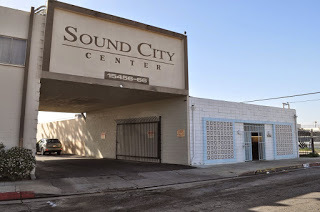 I grew up in the San Fernando Valley, tract homes and swimming pools, the end result of The Flintstone's Bedrock. My father made $89 a week and based on the very creative financing of the 60s, we could afford our own home, just like everybody else. When that no down payment philosophy went belly up, my family made a move to Florida; it was like we'd always been a day late and a dollar short for the amenities of Paradise. It wasn't a good lesson my parents learned in FLA - that there is no paradise (missed it once, missed it twice) - but they did indeed learn it. When we got back to L.A., hard up for work, they took a job as apartment managers on Langdon Avenue in Van Nuys over by Busch Gardens and the brewery.
I grew up in the San Fernando Valley, tract homes and swimming pools, the end result of The Flintstone's Bedrock. My father made $89 a week and based on the very creative financing of the 60s, we could afford our own home, just like everybody else. When that no down payment philosophy went belly up, my family made a move to Florida; it was like we'd always been a day late and a dollar short for the amenities of Paradise. It wasn't a good lesson my parents learned in FLA - that there is no paradise (missed it once, missed it twice) - but they did indeed learn it. When we got back to L.A., hard up for work, they took a job as apartment managers on Langdon Avenue in Van Nuys over by Busch Gardens and the brewery. My mother was a backup singer for artists like Ray Conniff and Burt Bacharach, but she'd burnt a lot of bridges, used up her leverage, and all that was left was Sound City, around the corner from our apartment on Cabrito Road. She'd hang out and busk for work and act like she belonged. It paid off for awhile, but the industry was changing, progressing. Her kind of angelic choral accompaniment was a bit prehistoric; in the flick of a decade my mother had become a dinosaur.
 Neve 8028 Mixing BoardSound City was a recording studio incorporated in 1969 that was previously a showroom and studio for the British company, Vox. For more than forty years the studio was home to no fewer than 100 certified gold and platinum albums. Artists who recorded just down the street from us included Neil Young (omg, After the [fuckin'] Gold Rush; can you imagine?), Elton John (Caribou), Fleetwood Mac (self-titled, Rumours), Tom Petty (Damn the Torpedoes, Wildflowers), Foreigner (Double Vision), Jack's Mannequin, Tears for Fears, Elvis Costello, Nirvana - on and on. Although there is a wonderful documentary on the studio, simply called Sound City (produced by Foo Fighter Dave Grohl), there is little else in the way of a recorded history. As a wide-eyed boy, and knowing from my mother just what went on down the street from our little apartment, I feel like a veritable font of leftover information.
Neve 8028 Mixing BoardSound City was a recording studio incorporated in 1969 that was previously a showroom and studio for the British company, Vox. For more than forty years the studio was home to no fewer than 100 certified gold and platinum albums. Artists who recorded just down the street from us included Neil Young (omg, After the [fuckin'] Gold Rush; can you imagine?), Elton John (Caribou), Fleetwood Mac (self-titled, Rumours), Tom Petty (Damn the Torpedoes, Wildflowers), Foreigner (Double Vision), Jack's Mannequin, Tears for Fears, Elvis Costello, Nirvana - on and on. Although there is a wonderful documentary on the studio, simply called Sound City (produced by Foo Fighter Dave Grohl), there is little else in the way of a recorded history. As a wide-eyed boy, and knowing from my mother just what went on down the street from our little apartment, I feel like a veritable font of leftover information.Langdon Avenue was one typical Valley apartment complex after another, a swimming pool in the middle of each. There was a Howard Johnson's at one end, and at the other it met Cabrito. From there it was an industrial complex, an endless caravan of tractor trailers and livery; the noise would wake us at 3am.
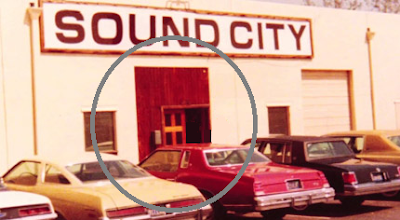 We lived halfway up the block. My mother would get dolled up and we'd stroll over to the Sound City complex. Depended on who was at the desk whether we went in. If it was Jo we'd sit inside and they'd chat and more than once my mother filled in when and if one of the vocalists didn't show. If it was Sheila, we'd go around back through the vestibule and hang by the cars until my mother could strike up a conversation. She didn't like Sheila. Essentially, she'd beg for work in that parking lot. They had enough money, but my mother had to sing. Gone were the Broadway dreams, but she had to sing.
We lived halfway up the block. My mother would get dolled up and we'd stroll over to the Sound City complex. Depended on who was at the desk whether we went in. If it was Jo we'd sit inside and they'd chat and more than once my mother filled in when and if one of the vocalists didn't show. If it was Sheila, we'd go around back through the vestibule and hang by the cars until my mother could strike up a conversation. She didn't like Sheila. Essentially, she'd beg for work in that parking lot. They had enough money, but my mother had to sing. Gone were the Broadway dreams, but she had to sing. 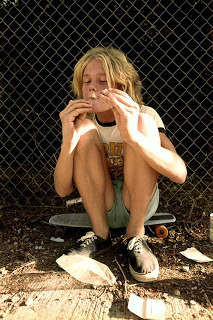
1974. There was a woman in the parking lot walking in a circle. My mother was leaning on the fender of a car. Every once in a while she'd let me bring my skateboard, and I'd tool around the lot. The studio door was open and from it came the guitar for "Frozen Love" (Buckingham Nicks). I was eleven with all kinds of thoughts that had never occurred to me in the past, and I couldn't stop looking at the girl as she wandered around the cars. Maybe she was 20, waif-like, hot as hell. My mother said, "Hey," and she said, "Hey." That was it. It was up to me. I landed an ollie in front of her, kind of lame, but I landed it. She said, "I sing on that song." She said it kind of disgusted.A man came to the door. He shouted, "Think you wanta join Fleetwood Mac?"
She looked at me. She said, suddenly grinning, "You think I oughta join Fleetwood Mac?"
I said, "I dunno." I didn't know what Fleetwood Mac was.
She said, "My name's Stevie." She waved at me, kind of silly-like, and ran to the man at the door.
Published on March 09, 2018 03:51
March 8, 2018
McCabe's
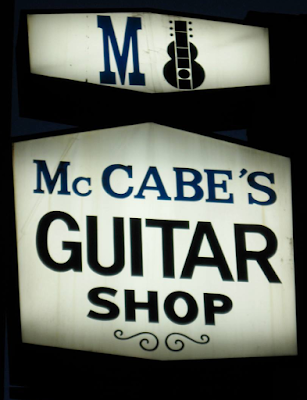 Watching a gig at McCabe's is an intimate, small stage affair that feels like what it is, getting up close and personal with a favorite artist.
Watching a gig at McCabe's is an intimate, small stage affair that feels like what it is, getting up close and personal with a favorite artist. Artists like Tom Waits in pared down solo performances in the back room, telling stories and singing from a single chair or at the piano. It’s the kind of intimacy that can bring a fan to tears. There are artists that repeat their albums when they perform live, perfecting a show for the road, those who sound nothing like a record without a sound engineer, and those that transcend those recordings as storytellers.
The experience is of course enhanced by the atmosphere at McCabe's. Wood paneled walls covered in every type of strummable: ukulele, banjo, mandoliine, dulcimer and more that I don't have names for, come together to create a world steeped in history. From Timothy Leary to Jeff Beck to Beck to Ginger Baker, the list of those who played at McCabe’s is endless. Why? If you don’t sound good here, you don’t sound good.
Published on March 08, 2018 05:54
Tom Waits For No One - McCabe's - Rock Landmarks L.A.
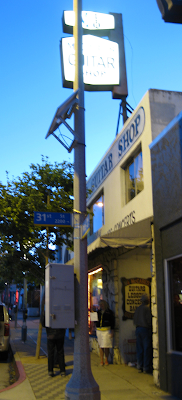 In the hallway Max Ten said, "Jay, picking you up Saturday." It wasn't a question, it was matter of fact. "Tom Waits. You've gotta hear this guy. Got a voice like an emery board. Fantastic."
In the hallway Max Ten said, "Jay, picking you up Saturday." It wasn't a question, it was matter of fact. "Tom Waits. You've gotta hear this guy. Got a voice like an emery board. Fantastic."Max Ten had a 1969 gold Austin America. He could have driven a four door Datsun and it would still be cool, but the Austin America was over the top. It had a Deadhead sticker on the back window and a cassette deck. Paige was in the back seat and at first I was a little taken aback. Was it all it ruse? A trick on Paigeboy's part, I don't know, but I felt a little more at ease with her there. I sat in the passenger seat and we picked up Belinda Pocket. The girls sat in back. Belinda wore a mini-dress that was pretty indescribable. Imagine a gypsy-style white top, pretty see through, but then below the elbows and below the waist it was a black and white paisley print. It was pretty stunning, and I've got to admit, Paigeboy looked like a million bucks in a pale green knitted dress, real short, hair parted in the middle, curled real nice. We headed out over the Sepulveda Pass into Santa Monica to a venue that wasn't much of anything, a converted storage space in the back of McCabe's Guitar Shop. It looked like the kind of place that would catch fire. There were a hundred guitars hanging on the walls, Gibsons and Fenders and Rickenbackers. There was a makeshift stage and a wall of amplifiers. Tom Waits was crazy and drunk and sang songs like "Ol' '55" and "Rosie." Leave it to Max Ten, the music was absolutely diabolical. It was always 2am in Waits' music and a bottle of Jack was paying you back, whispering loneliness. I wrote that in my red journal. Long ago I'd bought another journal and then another, but I kept that first one, the red one from Gaia for the stuff I never wanted to forget. I don't know if I said it or if it was Max Ten, but I at least was the one who wrote it down.
I never mentioned my father dancing. We were in Joe and Aggie's Café in Hollbrook, Arizona. We had chili con carne with onions and my father had a couple beers. We were playing a pinball machine called Gottlieb's Bowling Queen and my father went to the bar for another beer. A pretty lady in a cowboy hat started talking to him and the next thing I knew he was out on the floor and dancing a cowboy line dance. He didn't know what he was doing. I was so distracted that I let the fifth ball slip down between the flippers without enough for a replay, but I matched numbers and still got a free game. I didn't play it. I went and sat in the booth and watched my father dance. He was laughing the whole time and carrying on and when it was time for everybody in the line to tap the tip of their boots, he thought that was grand. It was the only part he really got down, otherwise he kept doing the wrong thing. It was real nice to see him have fun.
Tom Waits' didn't sing cowboy music, but there was an accordion and a cello in a couple of the numbers and I couldn't help but think about the dance my father did so poorly. Music can transport you places, so I was like back there in Arizona with my father. I think my father was back in the old west dancing at a hootenanny with a busty girl in a cowboy hat. He had a big old grin on his face. That's why I love music.
Paigeboy and I held hands in the back seat going home and then we parked up on Mulholland by Satan's black house with the Valley stretched out below and Max and I made out with the girls. I wasn't in love with Paige at all, but I was in love with the moment.
- From Jay and the Americans
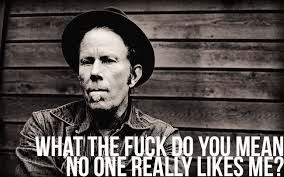 When I wrote Jay and the Americans, it was with the goal of keeping it 90% accurate. I'd been reading a lot of memoirs. For the first hundred pages or so, I'd find myself fascinated and then lose interest. The lack of plot in modern memoir was boring, no matter what The New York Times Book Review said. And so 90% of what is in Jay is the truth; the rest is fictional verisimilitude that serves as plot. I bring this up because Max Ten is real. Maxwell Tennial was the coolest kid at Van Nuys High and now the coolest dad and the coolest husband too, I suppose. I've always jokingly said that my man crush was Ellen, but really, it's Max Ten. OK, the point: Max sent me an email all about Waits after he read Jay and the Americans. I mean, how cool do you have to be to dis Waits? Am I right? Fucker even writes better than I do. Here's the email:
When I wrote Jay and the Americans, it was with the goal of keeping it 90% accurate. I'd been reading a lot of memoirs. For the first hundred pages or so, I'd find myself fascinated and then lose interest. The lack of plot in modern memoir was boring, no matter what The New York Times Book Review said. And so 90% of what is in Jay is the truth; the rest is fictional verisimilitude that serves as plot. I bring this up because Max Ten is real. Maxwell Tennial was the coolest kid at Van Nuys High and now the coolest dad and the coolest husband too, I suppose. I've always jokingly said that my man crush was Ellen, but really, it's Max Ten. OK, the point: Max sent me an email all about Waits after he read Jay and the Americans. I mean, how cool do you have to be to dis Waits? Am I right? Fucker even writes better than I do. Here's the email:Tom Waits is just awful.
I can imagine all the hipsters if they heard this statement, choking on their clove cigarettes, twisting their Smith Bros. beards, tripping over the laces of cherry Doc Martens; the tattoo that says, "You’re Innocent When You Dream," starts to itch, her mocha latte spills, she forgets to record Portlandia. "How could you say such a thing?" she implies with a look of disdain.
Reality: I don’t think I have ever seen a negative review of Tom Waits. Cool people are required to love him, and only the coolest people write music criticism, ergo blah blah blah; an assumption is made that those who don’t like him are listening to the Disney girls and Radio Banal.
I guess I'm just annoyed. If Waits had simply sung his songs like a normal human being instead of the Incredible Hulk (Tom Waits Smash), I'd have no reason to call him out; maybe if he didn't hope to expressly appeal to the margins of cool, to those college kids and the eternally infantine who prop up the Avant-Garde willy-nilly, I'd have nothing to complain about, but the newly devoted are the same types impressed by Duchamp's urinal in the same way that a four year old is thrown into hysterics by a floater in the bathtub. These folks play Rain Dogs in public at top volume to show how edgy they are, how unlike Mom and Dad. They prove that they are "artists" instead of frat boys by putting on Waits during the evening shift at Jamba Juice.
Point is, even the gods are flawed, or fall. Joni Mitchell comes to mind. From the sixties through Don Juan’s Reckless Daughter in 1977 she could do no wrong. Sometime after that she got bored, seemingly with her own talent, or she was far too influenced by the culture of cool, and, like Waits, began channeling old black men. We need Joni doing Charles Mingus about as much as we need a blonde Mingus singing "Circle Game."
For me Waits announces the coming of the art student in paint-splattered coveralls and gauges and dirt strategically left in the most visible places. Every move screams, "Look at me! I’m different; I'm post-colonial, post postmodern, deconstructing all I see and hear and step over; I must dress exactly like all other art students, rearranging the dirt and tattoos and duct tape, assuring that I recycle (but 'God don’t take away my K-cups.')"
So, yes, J’accuse! I object. How excited I was when "In the Neighborhood" was in rotation on MTV. Something new. "Look at this guy!" Or when he appeared in Rumblefish. Waits was cool exemplified - but all the hipsters have ruined that, reminded me that this is a fallen God. Ho-hum.
Swordfishtrombones is indeed a ten, the albums that preceded it are iconic, and there is nothing less beautiful about Franks Wild Years (sic), but that voice. Bowie said that Dylan had a voice like "sand and glue." The difference: that is Dylan; that's how he sounds. He's not a caricature of himself, a parody. Hipsters United has embraced the wrong Waits and I guess that's why I’m so bitter. Waits should be a ten all the way around. Makes me so angry. Just sing, Tom, like on "Neighborhood" or "Please Call Me, Baby." Sing like Waits sings, not like Waits with a trach. Okay, I'm done now. End of rant.
Jay and the Americans is available all over the world!
CreateSpace - Amazon - Amazon UK - Amazon France - Amazon Russia
Published on March 08, 2018 04:06
March 7, 2018
Capitol Records and Jane Gray
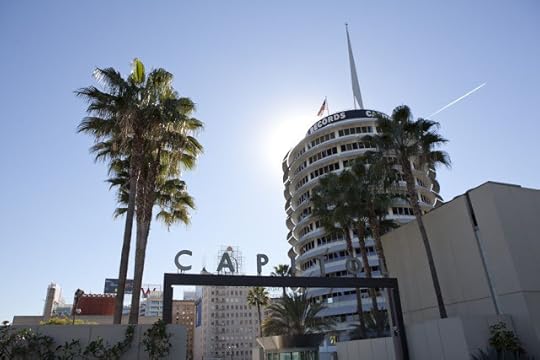 Located just north of Hollywood and Vine, the landmark Capitol Records Building was designed by Welton Becket, the architect who also designed the Music Center, the Cinerama Dome, and the Santa Monica Civic Auditorium. The 13-story tower, which resembles a stack of records, was the world's first circular office building when it was completed in April 1956. It is a mid-century modern icon.
Located just north of Hollywood and Vine, the landmark Capitol Records Building was designed by Welton Becket, the architect who also designed the Music Center, the Cinerama Dome, and the Santa Monica Civic Auditorium. The 13-story tower, which resembles a stack of records, was the world's first circular office building when it was completed in April 1956. It is a mid-century modern icon.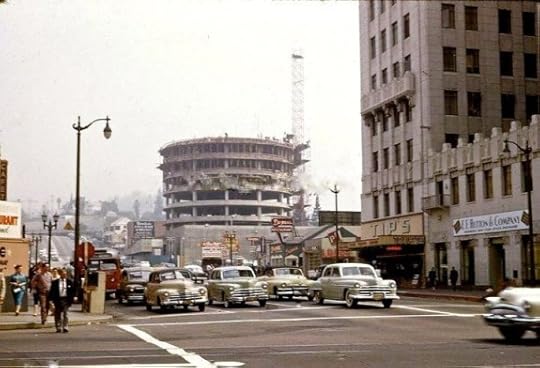
The Capitol Records Building is the site of the historic Capitol Studios, where Frank Sinatra, The Beach Boys, Nat King Cole, Paul McCartney, and a myriad of music legends recorded some of the most treasured music in history. The first album recorded at Capitol Studios was Frank Sinatra Conducts Tone Poems of Color, among the first concept LPs.
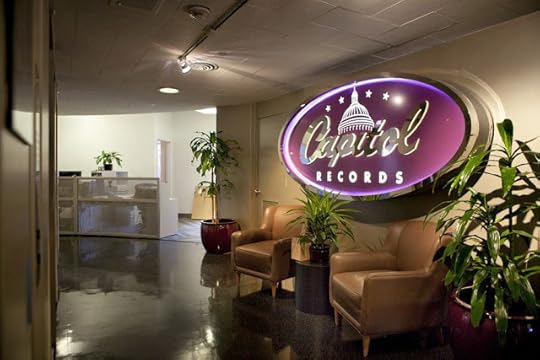
But what gives Capitol Studios its great sound qualities? Why do artists dream of recording there? At Capitol, much of this magic is attributed to a curious design element created by Les Paul, the guitarist and inventor of the famous Gibson Les Paul guitar. Paul was commissioned to give the studios reverb, the sonic quality of echo and delay. Paul built a series of eight cavernous trapezoidal echo chambers dug 30 feet below the Capitol Records building. The sparse concrete chambers, each with there own unique characteristics, have speakers on one side and microphones on the other. Sound engineers working in the studios above can pipe audio into the reverb chambers and re-record the sound, adding as much as a five second delay, giving singers a booming vocal quality that makes it sound more like the track was recorded in a cathedral, not a sound studio in L.A. The difference is huge. The effect is perhaps most famously heard on The Beach Boys' "Good Vibrations."
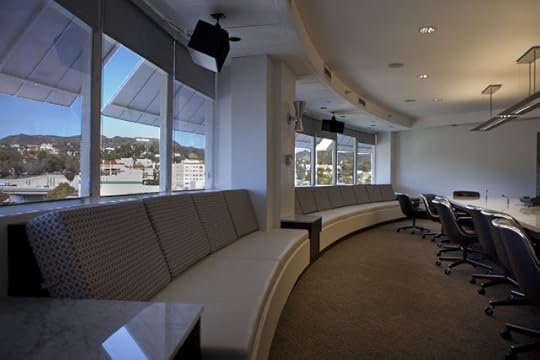 The black and white graphic image of the building which appears on albums became iconic in itself, as did the phrase, "From the Sound Capitol of the World."
The black and white graphic image of the building which appears on albums became iconic in itself, as did the phrase, "From the Sound Capitol of the World."
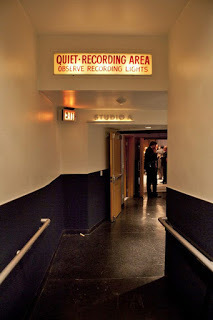 The building itself was indeed designed to look like a stack of LPs with the 90 foot spire at the top resembling a tone arms needle. The needle is topped by a red light that continuously blinks the word "Hollywood" in Morse code. The light was turned on when the building opened in 1956 - Leila Morse, the granddaughter of Samuel Morse, threw the switch.
The building itself was indeed designed to look like a stack of LPs with the 90 foot spire at the top resembling a tone arms needle. The needle is topped by a red light that continuously blinks the word "Hollywood" in Morse code. The light was turned on when the building opened in 1956 - Leila Morse, the granddaughter of Samuel Morse, threw the switch. There are certainly more famous studios. The Beach Boys, while alongside Frank Sinatra as Capitol's biggest selling artist, preferred Gold Star Studios (stayed tuned). Of course there is Abbey Road, A&M, Sunset Sound, The Hit Factory and Electric Lady, but these are all nondescript industrial settings. It's Capitol Records that still creates an aura that something great is happening inside. One can picture Frank Sinatra recording there with Nelson Riddle, stopping for lunch and wandering down Vine to the Tick Tock Restaurant or to Musso and Frank's. The famous Hollywood tower is one of music great landmarks.
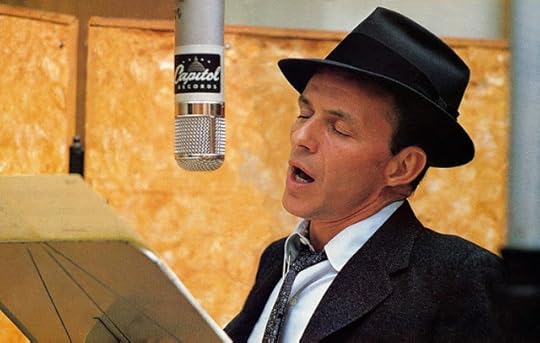

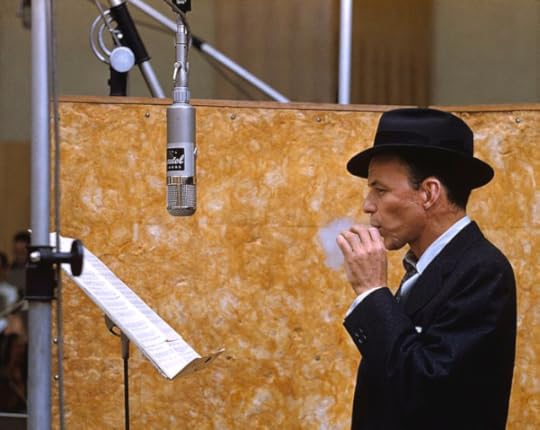
For the past umpteen years, I've been writing a psychological memoir that mimics The Picture of Dorian Gray. From the working title (Unblinking) to the format, I'm yet to be satisfied with the novel - but getting there. It's the story of Jane Gray, a former 60s pop star trying to make sense of her new 60s; not the decade, but her age. (Want to help bring Jane Gray to life? Buy Jay and the Americans.) Here's an excerpt from a scene that takes place at Capitol Records:
In my zeal, I kicked off my heels and knocked the box of photos from the striped bergère onto the floor. It is compelling to fit the pieces of what transpired into those few years I consider my youth. The things that happen in literature and in film have an authenticity, a verisimilitude that creates depth and round characterizations, while my life appears substantively unreal. But for the snapshots.
At 8:45am on April 7, 1968, for example, I walked into Capitol Records in Hollywood, California, an unknown 17-year old with a Mia Farrow hairdo and a lemon-yellow shift with appliquéd daisies tantamount to spring. I wore Ship'n Shore flats in white and brown that I'd bought from the Montgomery Ward catalog for $5.88. Fashion was good to me then.
And there it was, the building on the album covers, a building designed as a stack of 45s, its lobby arrayed with gold records from Sinatra and the Beatles and the Beach Boys. My appointment was on the 13th floor and I insisted that my parents stay back at the Roosevelt Hotel and go to breakfast. I entered the elevator a little ball of nervous confidence, a little high on amphetamines, and within the hour I had a good faith agreement to produce an album of songs to be determined, and the stage name Lady Jane.
"Miss Gray this is an opportunity that we [there was no one else in the room] would like you to view as la de da [I wasn’t listening]. Miss Gray? You will bring your parents to my office this afternoon?"
Later that day the cab driver took a Polaroid of mother and father and me, one of the few we ever took together. In my hands I am holding the contract that today hangs in a frame in the hallway.
But for these things, it could not be real.
The album was produced as if I was Dusty Springfield, but favored a Wall of Sound, everything at the same volume, hit you in the face American sensibility. There was a smash hit in the album's title song, "Leave Me Alone," a big-voiced mock-psychedelic ballad with a honky-tonk style due solely to the piano of Leon Russell. The other numbers, whether up-tempo or melancholy, each contained a quality the producer somehow deemed "appropriate" for a 17-year old girl, and included songs like "Anyone Who Had a Heart," "As Tears Go By," and "Hurt Me." Conceptually it seemed the world-weariness of youth was a quality found within my vocals (I thought it a bit ridiculous), yet somehow at my insistence they gave in and allowed me to sing "Popcorn Double Feature," a cover from the Searchers that went straight to number two, unable to topple "Green Tambourine" by the Lemon Pipers. The press panned the album for the most part, which I find humorous to this day, particularly in light of my residuals. What did they expect, Rubber Soul?
Published on March 07, 2018 03:53
March 6, 2018
Barney's Beanery - Rock Landmarks L.A.
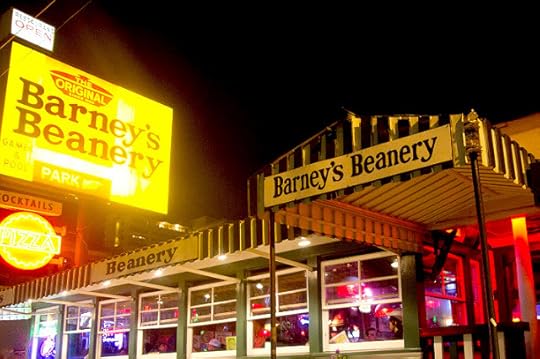 Located a couple blocks from the Alta Cienega, the landmark Barney's Beanery opened on Route 66 (Santa Monica Boulevard) in 1927. Barney's was a regular hangout for Jim Morrison, as well as Janis Joplin and many other rock legends and movie stars, with Marilyn Monroe a regular alongside James Dean (the roadhouse was the site of Dean's last meal before his tragic accident). Quentin Tarantino wrote Pulp Fiction while sitting at the bar.
Located a couple blocks from the Alta Cienega, the landmark Barney's Beanery opened on Route 66 (Santa Monica Boulevard) in 1927. Barney's was a regular hangout for Jim Morrison, as well as Janis Joplin and many other rock legends and movie stars, with Marilyn Monroe a regular alongside James Dean (the roadhouse was the site of Dean's last meal before his tragic accident). Quentin Tarantino wrote Pulp Fiction while sitting at the bar. The vibe is unpretentious with lots of rock memorabilia and a pool table, and its rep as a casual, come as you are roadhouse has maintained its appeal. That wasn’t always the case, though; Barney’s for years struggled to keep the roadhouse from becoming a gay bar in an area of L.A. known as Boys Town, going so far as to have matches printed with “Barney’s Beanery on one side and "No Faggots Allowed" on the other.
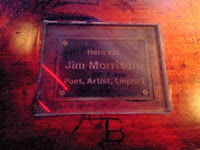 Jim Morrison would come in to drink after recording at The Doors Workshop just a bit further down Santa Monica Blvd. That is, until Morrison was inspired to stand on the bar and relieve himself. The decadent singer was immediately escorted out and not welcomed back (now there is a plaque on the bar honoring the Beanery's connection to Morrison, installed after Morrison’s sudden death in France in 1971).
Jim Morrison would come in to drink after recording at The Doors Workshop just a bit further down Santa Monica Blvd. That is, until Morrison was inspired to stand on the bar and relieve himself. The decadent singer was immediately escorted out and not welcomed back (now there is a plaque on the bar honoring the Beanery's connection to Morrison, installed after Morrison’s sudden death in France in 1971).Barney's even has its ghost stories. In September 1973, 25-year-old Leonard Taylor shot and killed Robert Rush, the 34-year-old bartender, over a game of pool. This documented murder has led to the belief that "The Man in Black," a specter often seen near the ladies' room, is Rush's spirit, still watching over the 8-ball games. Or maybe the mischievous spirit is that of Erroll Flynn, remembered as much for his sexual appetite as his acting. The playful ghost of Flynn is known to pull ponytails and push open the swinging kitchen doors so that they rock wildly on their hinges. Female employees often feel a touch on their back as if someone is trying to walk behind them, only to turn and realize the walkway is empty.
With almost 100 years of history under its belt, Barney's Beanery has seen just about everything. It was here that Morrison was hit over the head (deservedly, they say) by Janis Joplin with a nearly-full bottle of Jim Beam, so it's no surprise that it is home to paranormal entities as well as history. If you want to see a Hollywood staple and love a busy atmosphere, Barney's Beanery is a must. The history isn't just printed on the back of the menu, it's hanging on the walls, and felt in every corner of the roadhouse.
Published on March 06, 2018 08:28
One Degree of Separation - Rock Landmarks L.A.
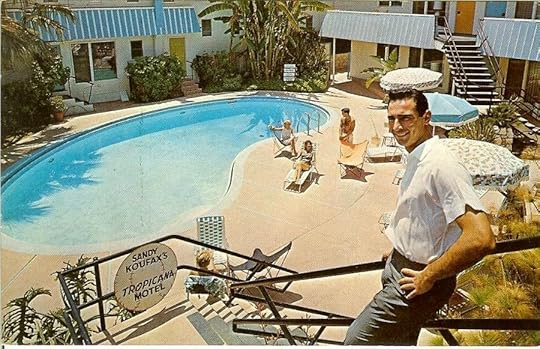 Pictured in 1963 in Perma Prest trousers and a crisp white shirt, is Dodgers' star pitcher Sandy Koufax at his way-cool financial investment, Sandy Koufax's Tropicana Motel. Koufax's name on the sign brought lots of new business to the declining motor lodge, but it was the location that, in the mid-60s onward, attracted its most famous guests. The Trop was within a stone's throw of the Hollywood rock venues and studios, and soon this family-oriented motel was anything but. From 1964 onward, the Trop functioned as a Boho playground, pioneered by Jim Morrison and the Doors who hung out after hours at the Palms, a low-rent so-called "dyke bar" across the street. Jim would drink there all night before stumbling "home" to the Trop, or to Duke's Coffee Shop in its lobby.
Pictured in 1963 in Perma Prest trousers and a crisp white shirt, is Dodgers' star pitcher Sandy Koufax at his way-cool financial investment, Sandy Koufax's Tropicana Motel. Koufax's name on the sign brought lots of new business to the declining motor lodge, but it was the location that, in the mid-60s onward, attracted its most famous guests. The Trop was within a stone's throw of the Hollywood rock venues and studios, and soon this family-oriented motel was anything but. From 1964 onward, the Trop functioned as a Boho playground, pioneered by Jim Morrison and the Doors who hung out after hours at the Palms, a low-rent so-called "dyke bar" across the street. Jim would drink there all night before stumbling "home" to the Trop, or to Duke's Coffee Shop in its lobby.
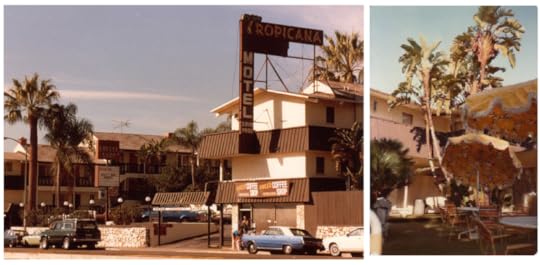
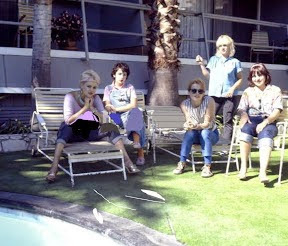 The Go Go's, 1979
The Go Go's, 1979
 Waves of musicians arrived over the years: Janis Joplin, Van Morrison, Eddie Cochran, the Beach Boys, Tom Waits, Led Zeppelin, William S. Burroughs; Frank Zappa’s Freak Outs were legendary. Over the years, the motel became the site of innumerable photo sessions and band interviews, and served as the location for the Andy Warhol films Heat and Trash. In the late 70s and 80s, new punk faces found their way into the motel and the greasy, affordable, open 24 hours, Duke's—Iggy and the Stooges, Blondie, the Go Go's, the Clash. (Woah, from Koufax to Morrison and Warhol in one degree of separation. Small world.)
Waves of musicians arrived over the years: Janis Joplin, Van Morrison, Eddie Cochran, the Beach Boys, Tom Waits, Led Zeppelin, William S. Burroughs; Frank Zappa’s Freak Outs were legendary. Over the years, the motel became the site of innumerable photo sessions and band interviews, and served as the location for the Andy Warhol films Heat and Trash. In the late 70s and 80s, new punk faces found their way into the motel and the greasy, affordable, open 24 hours, Duke's—Iggy and the Stooges, Blondie, the Go Go's, the Clash. (Woah, from Koufax to Morrison and Warhol in one degree of separation. Small world.) 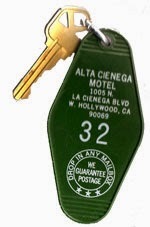 By the late 60s, The Trop had a reputation for all-night parties and debauchery. Said New West magazine, “Under the Trop's jungle-like foliage there were orgies, murders, suicides, ODs, love triangles, marriages, and drunken brawls on a daily basis." On any given night, you could be sleeping in a room (or trying to) next to Iggy Pop or witness a murder. (Put that on the post card!) The Trop is gone (replaced by the WeHo – oh brother – Ramada); yet another piece of rock history gone the way of Pandora's Box, the Trip and Gazzarri's.
By the late 60s, The Trop had a reputation for all-night parties and debauchery. Said New West magazine, “Under the Trop's jungle-like foliage there were orgies, murders, suicides, ODs, love triangles, marriages, and drunken brawls on a daily basis." On any given night, you could be sleeping in a room (or trying to) next to Iggy Pop or witness a murder. (Put that on the post card!) The Trop is gone (replaced by the WeHo – oh brother – Ramada); yet another piece of rock history gone the way of Pandora's Box, the Trip and Gazzarri's.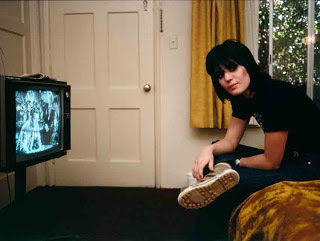
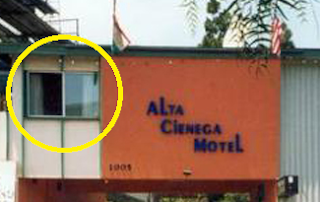 Top: Joan Jet at the Trop; Above: Room 32
Top: Joan Jet at the Trop; Above: Room 32Morrison switched digs in 1968 for the Alta Cienega near Santa Monica Blvd., adjacent to his fave strip club, The Phone Booth, and across from the Doors’ Workshop and Barney's Beanery. Unlike the Trop, the Alta Cienega is still there (1005 N. La Cienega Blvd.). From 1968 to 1970, the Alta Cienega served as Jim’s perennial residence (seemingly anytime he’d had a fight with Pamela Courson), and he’d trip around between his room (No. 32), Barney's, the Doors’ Workshop and Monaco liquors, each within stumbling distance. If you're even in L.A. and thinking about visiting Jim's room (indeed staying there), make sure you watch the Jim Morrison produced film HWY. In one of the final scenes, No. 32 is featured, in which Morrison is shown urinating; with that image in mind, don’t go to the Alta Cienega for the luxury accommodations; there is a definite ambiance that permeates the Alta Cienega, yet it is far removed from elegance or even comfort.
 Inside Room 32 today
Inside Room 32 today
Published on March 06, 2018 03:45
March 5, 2018
L.A.'s Rock Landmarks - The Canyon Country Store
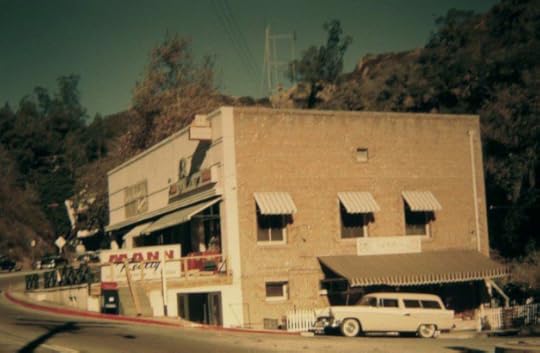 I've droned on about Laurel Canyon over the years. While I lived a canyon over in the early 1980s (Benedict Canyon – you would know that if you read Jay and the Americans), it was not the Canyon. L.A. Has a certain vernacular. "The City" meant Beverly Hills, a city engulfed by L.A. on all sides; "South of the Boulevard" meant the Hollywood Hills south of Ventura Blvd. in the Valley (which means the San Fernando Valley, and The Canyon means only Laurel, though there were many others that connect the Valley to the "Basin." Mama Cass was the Canyon's Gertrude Stein, we've established that, and Peter Tork was the west coast's Truman Capote and the purveyor of the naked party house. There was bowling at Zappa’s and Morrison lived on Love Street, but the one Canyon landmark that remains virtually unchanged is The Canyon Country Store, the makeshift cultural center of the L.C., indeed, the "store where the creatures meet."
I've droned on about Laurel Canyon over the years. While I lived a canyon over in the early 1980s (Benedict Canyon – you would know that if you read Jay and the Americans), it was not the Canyon. L.A. Has a certain vernacular. "The City" meant Beverly Hills, a city engulfed by L.A. on all sides; "South of the Boulevard" meant the Hollywood Hills south of Ventura Blvd. in the Valley (which means the San Fernando Valley, and The Canyon means only Laurel, though there were many others that connect the Valley to the "Basin." Mama Cass was the Canyon's Gertrude Stein, we've established that, and Peter Tork was the west coast's Truman Capote and the purveyor of the naked party house. There was bowling at Zappa’s and Morrison lived on Love Street, but the one Canyon landmark that remains virtually unchanged is The Canyon Country Store, the makeshift cultural center of the L.C., indeed, the "store where the creatures meet."At the intersection of Kirkwood Drive and Laurel Canyon Blvd. a small inn called the Bungalow Lodge opened in the early 1900s (there's conflicting information on the exact date), catering primarily to hunters. The Lodge went up in flames in 1929. Reconstruction using brick and stones (from the original river that flowed where Laurel Canyon Blvd. is now) began later that year, and the spot was re-fashioned as a local market. Thus, the Canyon Country Store was born.
At the height of the counterculture movement of the 1960s, Laurel Canyon became southern California's answer to Haight-Ashbury in San Francisco, though less psychedelic and far more bohemian. Throughout the '60s and '70s, the Laurel Canyon Country Store acted as a meeting place for these musicians to write songs together and jam on the market's front patio. Mitchell wrote Ladies of the Canyon and Nash wrote CSNY's "Our House" about the neighborhood. Most famously of all, Cass Elliot lived in the shop's basement (now a fancy wine cellar) for a spell.
Jim Morrison's semi-constant companion, Pamela Courson, probably frequented the country store most of all. The contentious pair lived right behind the market at 8021 Rothdell Trail and opened their home to seemingly all artists and travelers who came past. According to Laurel Canyon lore, during a Morrison/Courson main event, folks hanging out at the market would watch Jim's books and clothing flying out of the top windows.
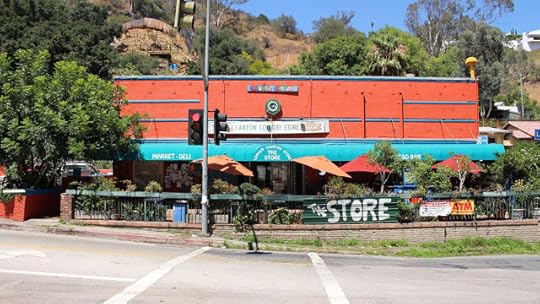
In the '80s the Canyon shifted from bohemian nucleus to secluded enclave, and rock stars flocked to the neighborhood for the quiet life. But legends continued to frequent the Country Store in search of their favorite goods, including chocolate. Mick Jagger came for the "English Kit Kats on hand," while David Bowie repeatedly purchased Flakes, his favorite Cadbury chocolate bar.
The clientele today ranges from old-timer hippies to the wives of studio executives stopping in for packs of cigarettes. What might have served as the location for a sit-in is now the perfect spot to enjoy a sandwich and the calming sound of L.A. traffic. If you play your cards right, the twenty-somethings working at the cash register (the same job Jennifer Aniston worked before landing Friends), will offer you your receipt, hand-lettered with the phrase, "You are loved." Peace signs in the Os, of course.
Published on March 05, 2018 13:51
Cass Elliot - Gertrude Stein of Laurel Canyon
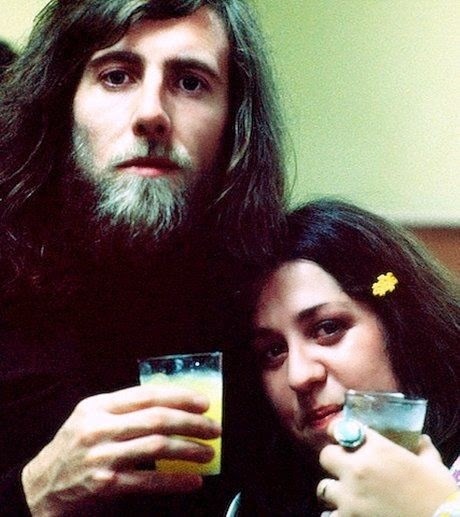 Graham Nash & Mama CassA huge buzz in the Laurel Canyon community in the mid '60s surrounded the auditions to find four wacky musicians for a television show called The Monkees. Originally, Stephen Stills of Buffalo Springfield auditioned for a part, but his "snaggle tooth" kept him from nabbing the role. So instead, he recommended his roommate, flower child Peter Tork. Their comedy genius (John Lennon likened The Monkees to the Marx Brothers) combined with some of the greatest songwriters of the decade (Boyce & Hart, Neil Diamond and Laurel Canyon resident songwriter Carole King) would eventually earn them respect as bona fide performers. In addition, Dolenz and Tork's homes were known for some of the most famous - and infamous - parties in the canyon.
Graham Nash & Mama CassA huge buzz in the Laurel Canyon community in the mid '60s surrounded the auditions to find four wacky musicians for a television show called The Monkees. Originally, Stephen Stills of Buffalo Springfield auditioned for a part, but his "snaggle tooth" kept him from nabbing the role. So instead, he recommended his roommate, flower child Peter Tork. Their comedy genius (John Lennon likened The Monkees to the Marx Brothers) combined with some of the greatest songwriters of the decade (Boyce & Hart, Neil Diamond and Laurel Canyon resident songwriter Carole King) would eventually earn them respect as bona fide performers. In addition, Dolenz and Tork's homes were known for some of the most famous - and infamous - parties in the canyon.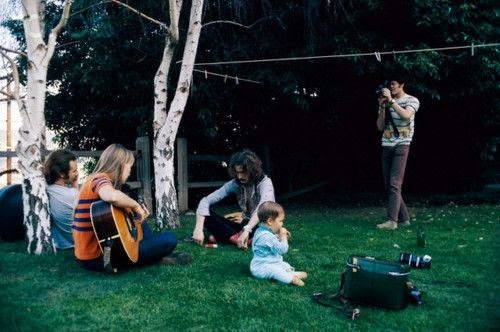 David Crosby, Joni Mitchell, Eric Clapton, Owen Elliot & Mickey Dolenz
David Crosby, Joni Mitchell, Eric Clapton, Owen Elliot & Mickey Dolenz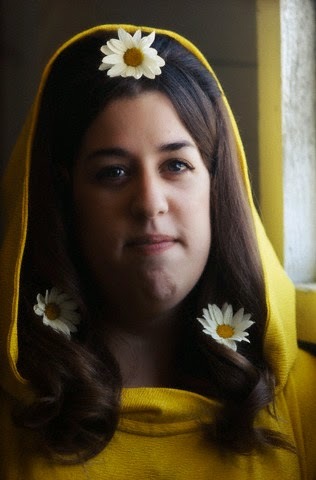 Known as Laurel Canyon's "Gertrude Stein," Mama Cass Elliot was one of the canyon's most beloved residents, and was known to host legendary get-togethers as well as for making connections between her musician friends that would change American music history. Gertrude Stein had served this role for the American expatriates in Paris in the 1920s, single-handedly bringing the modern art movement to prominence and helping to launch the careers of Hemingway, Picasso and James Joyce.
Known as Laurel Canyon's "Gertrude Stein," Mama Cass Elliot was one of the canyon's most beloved residents, and was known to host legendary get-togethers as well as for making connections between her musician friends that would change American music history. Gertrude Stein had served this role for the American expatriates in Paris in the 1920s, single-handedly bringing the modern art movement to prominence and helping to launch the careers of Hemingway, Picasso and James Joyce. In the fickle world of music it wasn't unusual for bands to break up and its members to regroup with other musicians. The Crosby, Stills & Nash blend had been brewing for a while. In-fighting within Crosby's and Stills' bands caused Stills to leave the Buffalo Springfield and Crosby to be kicked out of The Byrds. The two decided to form their own short-lived group, the Frozen Noses. It was during this time that Crosby, on a trip to Florida, discovered a fair-haired Canadian folk singer named Joni Mitchell. So impressed by her musical brilliance, he brought her back to L.A. and over to Mama Cass' house. Joni was a triple threat - an angelic voice, a poetic writer and a uniquely accomplished guitar player. Even Eric Clapton on a visit to Laurel Canyon was in awe watching Mitchell's unique guitar playing style. With Mitchell moving into the neighborhood and Crosby and Stills singing together as a duo, Mama Cass made a connection that would make music history in more ways than one! Cass knew the duo needed another voice even if they didn't, and she also knew that British pop star Graham Nash was not very happy in his group, The Hollies. Cass arranged a meeting between the three harmonic singers, and Crosby, Stills & Nash was born. And, of course, so was the relationship between Joni and Graham.
Watch this video on The Scene.
Published on March 05, 2018 04:49
March 3, 2018
Blues From Laurel Canyon - John Mayall
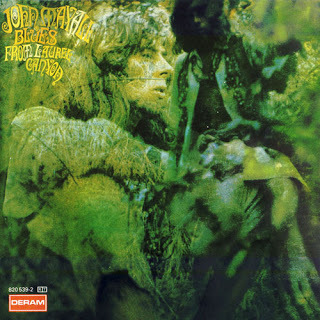 Sgt Pepper established the concept album as a construct in rock music; the first concepts coming out of the 50s with loosely strewn ideas that established an LP’s mood: Sinatra's In the Wee Small Hours of the Morning and Come Fly With Me come to mind. By 1967 and Sgt. P, the construct had been tested with LPs like Days of Future Passed and would meld into albums like Tommy, Ziggy Stardust and Zappa's Joe's Garage. In that artsy context, British bluesman John Mayall seemed an unlikely candidate, and yet in late '67 after disbanding The Bluesbreakers (a revolving-door of upcoming artists that included Eric Clapton, Mick Fleetwood, John McVie and Jack Bruce), Mayall took a three week vacation in L.A., you know, swimmin’ pools, movie stars; the land of the Byrds and Zappa, Captain Beefheart, Canned Heat, perfect weather, young women (young was very much Mayall's thing) and marijuana – a vacation that would inevitably last ten years. Those first three weeks, though, staying with friend Bob "The Bear" Hite of Canned Heat, would translate into Blues From Laurel Canyon.
Sgt Pepper established the concept album as a construct in rock music; the first concepts coming out of the 50s with loosely strewn ideas that established an LP’s mood: Sinatra's In the Wee Small Hours of the Morning and Come Fly With Me come to mind. By 1967 and Sgt. P, the construct had been tested with LPs like Days of Future Passed and would meld into albums like Tommy, Ziggy Stardust and Zappa's Joe's Garage. In that artsy context, British bluesman John Mayall seemed an unlikely candidate, and yet in late '67 after disbanding The Bluesbreakers (a revolving-door of upcoming artists that included Eric Clapton, Mick Fleetwood, John McVie and Jack Bruce), Mayall took a three week vacation in L.A., you know, swimmin’ pools, movie stars; the land of the Byrds and Zappa, Captain Beefheart, Canned Heat, perfect weather, young women (young was very much Mayall's thing) and marijuana – a vacation that would inevitably last ten years. Those first three weeks, though, staying with friend Bob "The Bear" Hite of Canned Heat, would translate into Blues From Laurel Canyon.The LP recounts Mayall's trip from London ("Ten hours in plane, England left behind") and relates his "Walking on Sunset," encountering the likes of Zappa and Canned Heat ("2401" and "The Bear") and his return to England.
 Mayall was much older than his musical cohorts (he was 35 and his former guitarist Clapton was still only 23) and so he wasn't easily swayed by the psychedelic scene, it's laid back, somewhat lethargic style; indeed he recorded Blues in just three days, in a time when Brian Wilson would spend six months perfecting "Good Vibrations."
Mayall was much older than his musical cohorts (he was 35 and his former guitarist Clapton was still only 23) and so he wasn't easily swayed by the psychedelic scene, it's laid back, somewhat lethargic style; indeed he recorded Blues in just three days, in a time when Brian Wilson would spend six months perfecting "Good Vibrations." In 1967, my mother, brother and I lived in the Valley where my brother and I shared a bedroom and my mother slept on a pull-out in the living room. My brother would borrow the car, a 1961 Ford Falcon, and head down to Hollywood. When my mother was "out," I'd sometimes get to go along (I was six or seven). We'd head down to Hollywood to Wallach’s Music City, grab a handful of records and sit all night in a listening booth. When I wasn't along, my brother would frequent the clubs: "I used to take the car from Van Nuys over Laurel Canyon to Sunset and go to the Whiskey or The Trip or The Sea Witch. I saw Fleetwood Mac pre-Buckingham-Nicks, Flying Burrito Brothers, The Doors and John Mayall. He wore a Mexican belt with like 20 harmonicas in place of ammo. It's why I relate so strongly to many of the songs, from the opening Mick Taylor guitar solo to 'Walking on Sunset' and "Medicine Man" and "The First Time Alone". AM's always going on and on about Laurel Canyon. Can't believe they're only just getting around to Blues From Laurel Canyon."
When Graham Nash sings about "Our House" we get a glimpse of Laurel Canyon. Despite the depth of the artists who shared the enclave, Laurel Canyon was simple and homey. Still, the Laurel Canyon crowd never created a pastiche of the real L.A. the way that Mayall does on Blues; one might think he was walking down Sunset over the weekend. I listen and I can see my father painting one of the Sunset billboards.
Published on March 03, 2018 04:13



